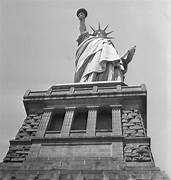On October 28, 1886, one of the most iconic symbols of freedom and democracy was unveiled in New York Harbor – the Statue of Liberty. A gift from the people of France to the United States, the statue has since become a universal symbol of hope, welcoming immigrants and serving as a beacon of liberty. The idea for the Statue of Liberty originated from Édouard de Laboulaye, a French politician and abolitionist, who proposed the idea as a tribute to the United States' commitment to democracy and liberty. The statue was designed by French sculptor Frédéric Auguste Bartholdi, with the assistance of engineer Gustave Eiffel, who would later build the Eiffel Tower. Construction of the statue began in France in 1875, and it was completed in 1884. The statue, officially titled "Liberty Enlightening the World," depicts a female figure holding a torch in one hand and a tablet inscribed with the date of American independence in the other. She stands atop a pedestal, which bears the inscription of the famous poem "The New Colossus" by Emma Lazarus, with the memorable lines: "Give me your tired, your poor, your huddled masses yearning to breathe free." After its completion, the statue was disassembled and shipped to the United States. It arrived in New York Harbor in June 1885, and its reassembly and construction of the pedestal took over a year. Finally, on October 28, 1886, President Grover Cleveland presided over the dedication ceremony, and the Statue of Liberty was unveiled to the public. The Statue of Liberty quickly became a symbol of hope and freedom for millions of immigrants arriving in America seeking a better life. As ships entered New York Harbor, the sight of the statue provided a sense of relief and optimism, representing the opportunities and possibilities that awaited them in their new homeland. Over the years, the Statue of Liberty has come to represent the core values of the United States – freedom, democracy, and the pursuit of happiness. It has stood as a reminder of the nation's commitment to welcoming immigrants and embracing diversity. The statue has become an enduring symbol of the American dream, inspiring generations of people from all over the world. In addition to its symbolism, the Statue of Liberty has also become a major tourist attraction. Visitors can take a ferry to Liberty Island and explore the statue's pedestal, museum, and observation deck. The statue's crown was reopened to the public in 2009, allowing visitors to climb up and enjoy panoramic views of New York City. Throughout its history, the Statue of Liberty has undergone various restorations and renovations to ensure its preservation. In 1984, it was designated as a UNESCO World Heritage site, recognizing its cultural and historical significance.
28 Oct, 1826 The Statue of Liberty
